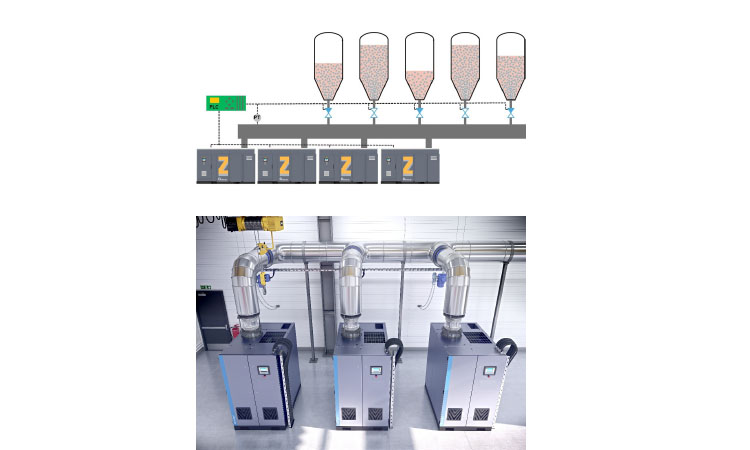We recommend having aeration equipment that is dedicated to the fermentation process and sized appropriately for process needs. Energy savings from supplying only the required air pressure can be quite significant in continuous applications.
Why is this important? The electrical cost for operating compressor equipment continuously can be quite high. Compressing air to 100 psi and then throttling it down to 25 psi is a large and unnecessary expenditure of energy. In general, we recommend having aeration equipment that is dedicated to the fermentation process and sized appropriately for process needs. Table A shows the energy required to produce air at these pressures vs. instrument air that was compressed to 100 psi for a flow of 200 cubic feet per minute (cfm).
As Table A shows, energy savings from supplying only the required air pressure can be quite significant in continuous applications. The cost for a single-stage, oil-free compressor producing 200 cfm is in the range of $50,000 for a complete package, including filtration and an aftercooler (heat exchanger). Depending on actual energy costs and operating hours, simple payback of a dedicated single-stage compressor would be 3–5 years. This could potentially be reduced even further if a smaller air compressor were purchased.
The compressor system supplies air to the fermentation tank using an aeration device such as a sparger, perforated tubing, or diffuser system, typically installed at the bottom of the tank to allow oxygen to disperse as it rises through the liquid. Additional agitators may be used to distribute air bubbles evenly throughout the liquid in the tank.
Oxygen content is monitored with dissolved oxygen (DO) probes, since the level of DO required varies throughout the fermentation process, depending on desired growth or reaction rates. To meet this variable demand, the compressor system must able to produce varied amounts of airflow. This can be achieved by using multiple units that are turned on or off as needed, load/unload control, or variable-frequency drives (VFDs) to control compressor operating speeds. The VFD approach saves energy, but more importantly, allows for the tightest control of DO levels. This not only ensures that the required oxygen demand is always met, but it can also improve production yields by providing the ideal oxygen level for all process steps.
To achieve the most functional outcome, it is important to select a compressor system that can meet the maximum and minimum expected flow demand without any gaps between the two. Screw compressors have a turndown ratio—the ratio of maximum to minimum flow—that is approximately 3:1 when run with a VFD. Drastic variations in flow demand may require compressor systems that utilize several smaller machines, while more constant demand can be handled with fewer or even one machine. A fermentation system with a common header and multiple compressors is shown in Figure 1.
DO control in fermentation tanks is managed with a closed proportional–integral–derivative (PID) loop that has an output to control the total required flow from the compressor system. The standard method is to have the header system supplied with a fixed pressure setpoint, with valves for each fermentation tank controlled for respective vs. required DO levels. More advanced control functions based on system flow and flow to each tank can also be implemented to reduce header pressure and energy consumption.
Designing Aeration Systems
An often-overlooked consideration in aeration systems is the plant design itself. As discussed, it is common practice for multiple fermenters to run from a common “header” pipe that supplies air to each tank. Although this is acceptable, liquid levels may vary from one tank to the next. When this is the case, the compressor system will have to create enough pressure to operate the deepest tanks, even though the others require less pressure when aerated individually. This can result in unnecessary energy costs that could have been avoided by separating systems based on expected liquid levels. To combat unnecessary energy use, tanks with roughly the same system pressure requirements should be on a common header system; tanks with large variable pressure needs should have dedicated aeration equipment.
There are several factors to consider when justifying the extra equipment required for this setup. The required flow to each tank and the pressure difference between tanks must be significant enough to have a reasonable payback period. Considering the example given earlier, if we have one tank that requires 200 cfm at only 25 psi(g) and another that requires 200 cfm at 45 psi(g), then a separate system would save -$9,000 per year in energy. This would require an additional compressor whose cost is -$50,000, yielding a payback of < 6 years. Factoring in the extra maintenance costs of the second compressor, equal to 3% of the capital cost per year, gives a slightly longer payback of -6.5 years.
Features for Reliable Operation
The compressor equipment should have several features to meet fermentation process requirements.
Equipment reliability: A backup compressor for each header system should always be in place, since unreliable equipment can lead to multiple machines down and a system unable to meet oxygen demands. Although nonfunctioning equipment is most often the result of extreme conditions or unexpected circumstances, the cost of unusable end product(s) may be greater than the compressor equipment investment.
Energy efficiency: As we have seen, single-stage equipment designed for the lower operating pressures of fermentation tanks can greatly reduce operating costs. VFD equipment further improves this efficiency to accommodate variable oxygen demands at various stages of fermentation.
Controllability: A supervisory control and data acquisition (SCADA) or distributed control (DCS) system in the plant should be able to operate compressor equipment seamlessly, varying the speed as the system requires. Compressors that utilize integrated controls can perform this function while they monitor critical parameters, making sure the equipment is protected while being controlled remotely.
Conclusion
In summary, aeration is a critical element for producing pharmaceuticals via aerobic fermentation processes. Consideration should be given to the system layout, control scheme, and compressor equipment to ensure that fermentation tanks always have a reliable source of air to meet the oxygen demand. Following these guidelines will ultimately lead to smooth, reliable plant production at the lowest possible operational cost.






